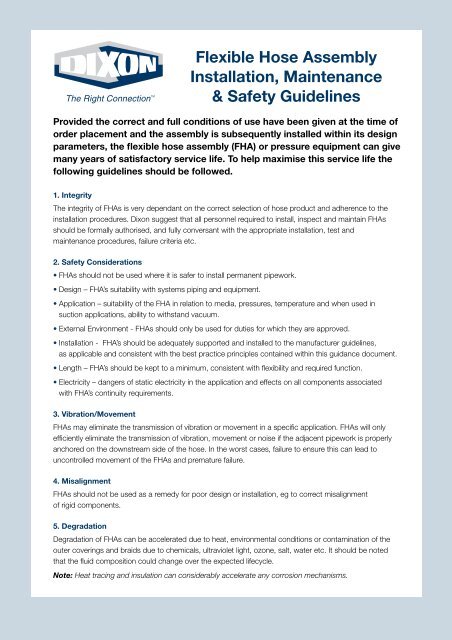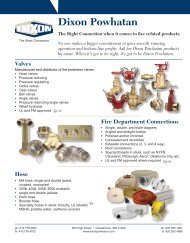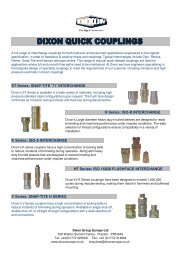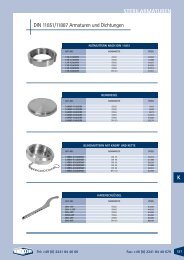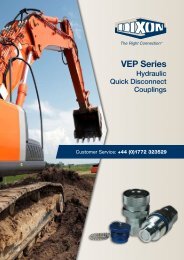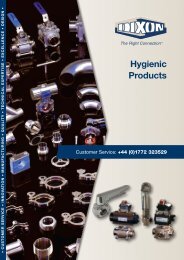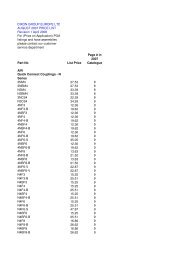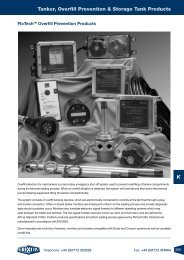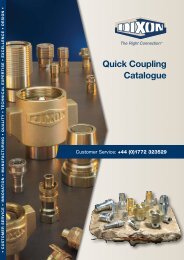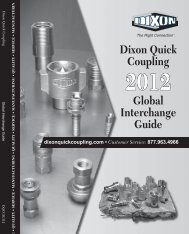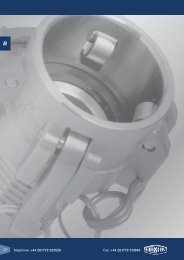Flexible Hose Assembly Installation, Maintenance & Safety Guidelines
Flexible Hose Assembly Installation, Maintenance & Safety Guidelines
Flexible Hose Assembly Installation, Maintenance & Safety Guidelines
Create successful ePaper yourself
Turn your PDF publications into a flip-book with our unique Google optimized e-Paper software.
<strong>Flexible</strong> <strong>Hose</strong> <strong>Assembly</strong><br />
<strong>Installation</strong>, <strong>Maintenance</strong><br />
& <strong>Safety</strong> <strong>Guidelines</strong><br />
Provided the correct and full conditions of use have been given at the time of<br />
order placement and the assembly is subsequently installed within its design<br />
parameters, the flexible hose assembly (FHA) or pressure equipment can give<br />
many years of satisfactory service life. To help maximise this service life the<br />
following guidelines should be followed.<br />
1. Integrity<br />
The integrity of FHAs is very dependant on the correct selection of hose product and adherence to the<br />
installation procedures. Dixon suggest that all personnel required to install, inspect and maintain FHAs<br />
should be formally authorised, and fully conversant with the appropriate installation, test and<br />
maintenance procedures, failure criteria etc.<br />
2. <strong>Safety</strong> Considerations<br />
• FHAs should not be used where it is safer to install permanent pipework.<br />
• Design – FHA’s suitability with systems piping and equipment.<br />
• Application – suitability of the FHA in relation to media, pressures, temperature and when used in<br />
suction applications, ability to withstand vacuum.<br />
• External Environment - FHAs should only be used for duties for which they are approved.<br />
• <strong>Installation</strong> - FHA’s should be adequately supported and installed to the manufacturer guidelines,<br />
as applicable and consistent with the best practice principles contained within this guidance document.<br />
• Length – FHA’s should be kept to a minimum, consistent with flexibility and required function.<br />
• Electricity – dangers of static electricity in the application and effects on all components associated<br />
with FHA’s continuity requirements.<br />
3. Vibration/Movement<br />
FHAs may eliminate the transmission of vibration or movement in a specific application. FHAs will only<br />
efficiently eliminate the transmission of vibration, movement or noise if the adjacent pipework is properly<br />
anchored on the downstream side of the hose. In the worst cases, failure to ensure this can lead to<br />
uncontrolled movement of the FHAs and premature failure.<br />
4. Misalignment<br />
FHAs should not be used as a remedy for poor design or installation, eg to correct misalignment<br />
of rigid components.<br />
5. Degradation<br />
Degradation of FHAs can be accelerated due to heat, environmental conditions or contamination of the<br />
outer coverings and braids due to chemicals, ultraviolet light, ozone, salt, water etc. It should be noted<br />
that the fluid composition could change over the expected lifecycle.<br />
Note: Heat tracing and insulation can considerably accelerate any corrosion mechanisms.<br />
2
6. Storage<br />
All FHAs should be stored in clean, dry conditions and hoses of rubber and composite construction<br />
should be kept in a cool atmosphere protected from direct sunlight. Some hose linings, if not protected<br />
prior to putting into service, have a finite shelf-life.<br />
7. Cleaning and Flushing<br />
All components used in a system that includes a FHA should be cleaned and flushed prior to use,<br />
to prevent debris being carried, damaging the liner of the hose.<br />
8. Operations, <strong>Maintenance</strong>, Inspection & Testing<br />
Users should ensure that all FHAs are subject to a periodic inspection routine. Only authorised,<br />
competent personnel should be permitted to install, inspect and maintain flexible hose lines. Visual<br />
inspection of the hose body for cuts, kinks, bulges, signs of abrasion, corrosion products etc. Particular<br />
attention should be focused close to the end coupling for signs of over-bending or leakage.<br />
9. Changing Conditions<br />
The user should be aware of changing conditions, which may move the FHAs away from the original<br />
design intent. Changes can include, but are not limited to: pressure, temperature, flow, media etc.<br />
10. User’s/Purchaser’s Responsibility to Define Requirements<br />
The user or purchaser of any FHA should always ensure that the following information is provided<br />
as applicable:<br />
Always consider and properly define the application of the FHA by referring to:<br />
STAMPED: Size, Temperature, Application, Media, Pressure, Ends, Dixon. In addition consider static<br />
or dynamic use of hose and the working environment.<br />
11. Legal Requirements<br />
It is a legal requirement under health and safety law, power regulations and the Pressure Equipment<br />
Directive 97/23/EC that those responsible for work activities ensure that hazards are adequately identified<br />
risks are adequately assessed and that suitable control measures are put into place.<br />
Dixon Group Europe are Certified to PED 97/23/EC Module D1<br />
by Lloyds Register Quality Assurance. Notified Body 0038<br />
Telephone: +44 (0)1772 323529 Fax: +44 (0)1772 314664
installation<br />
WRONG<br />
RIGHT<br />
Note: Poor installation can cause leaks and contamination<br />
<strong>Flexible</strong> <strong>Hose</strong> Assemblies (FHA’s)<br />
should always be handled with<br />
reasonable care, and should not<br />
be subjected to over straining.<br />
The design of hose supports and<br />
saddles should be to ensure that<br />
the minimum bend radius is<br />
not compromised.<br />
FHAs should never be forcefully<br />
deformed, crushed, twisted or<br />
subject to flow shut-off by kinking.<br />
Avoid routing or dragging FHAs<br />
over sharp or abrasive surfaces.<br />
FHAs should not be allowed to<br />
hang between equipment that can<br />
move and cause FHAs to become<br />
over-stretched or bent.<br />
The following considerations<br />
should be taken into account<br />
before the FHA is installed in either<br />
a static or flexing application.<br />
• It is essential that the mating<br />
couplings are completely free<br />
from foreign matter, burrs etc.<br />
Damage, corrosion or<br />
contamination to the mating<br />
surfaces will cause joint failure<br />
in service.<br />
• The installed bend radius of the<br />
FHA must not be less than the<br />
minimum bend radius specified.<br />
• Union Nuts should be hand<br />
tightened at both ends and the<br />
FHA be allowed to adopt its<br />
natural position prior to<br />
tightening.<br />
• FHAs should not be installed in<br />
a twisted condition, since this<br />
puts unbalanced tension on the<br />
hose and reduces the working<br />
life of the assembly.<br />
• FHAs should not be installed<br />
in applications where<br />
compression, axial extension,<br />
or torsion could occur.<br />
• Dixon always recommends the<br />
use of a ‘King’ <strong>Hose</strong> <strong>Safety</strong><br />
Restraint Cable on FHA’s.<br />
Telephone: +44 (0)1772 323529 Fax: +44 (0)1772 314664
TAKING FLEXIBLE HOSE ASSEMBLIES OUT OF SERVICE<br />
WRONG<br />
RIGHT<br />
FHA’s which have been taken out<br />
of service for a temporary period<br />
to be subsequently re-used at<br />
another time, should always<br />
have the media drained from the<br />
hose. The FHA should also be<br />
cleaned and flushed if required.<br />
The FHA should then be<br />
stored in clean, dry conditions.<br />
FHA’s of rubber and composite<br />
construction should be kept<br />
in a cool atmosphere protected<br />
from direct sunlight.<br />
FHA’s which have been identified<br />
as being unfit for purpose should<br />
have the end couplings removed,<br />
and the main carcass of the hose<br />
marked as ‘Scrap’. It should then<br />
be disposed of in line with<br />
regional disposal segregation<br />
procedures, taking into account<br />
decontamination requirements.<br />
For additional advice<br />
regarding installation,<br />
maintenance and the<br />
safe operational use of<br />
<strong>Flexible</strong> <strong>Hose</strong> Assemblies,<br />
please contact a member<br />
of the Dixon Sales Team<br />
Dixon Group Europe Ltd<br />
350 Leach Place<br />
Walton Summit Centre<br />
Preston, Lancashire, PR5 8AS<br />
T:+44(0)1772 323529<br />
F: +44(0)1772 314664<br />
www.dixoneurope.co.uk<br />
enquiries@dixoneurope.co.uk<br />
BE SAFE - ALWAYS SPECIFY DIXON PRODUCT<br />
Note: Poor installation reduces hose life and can be potentially hazardous<br />
1


